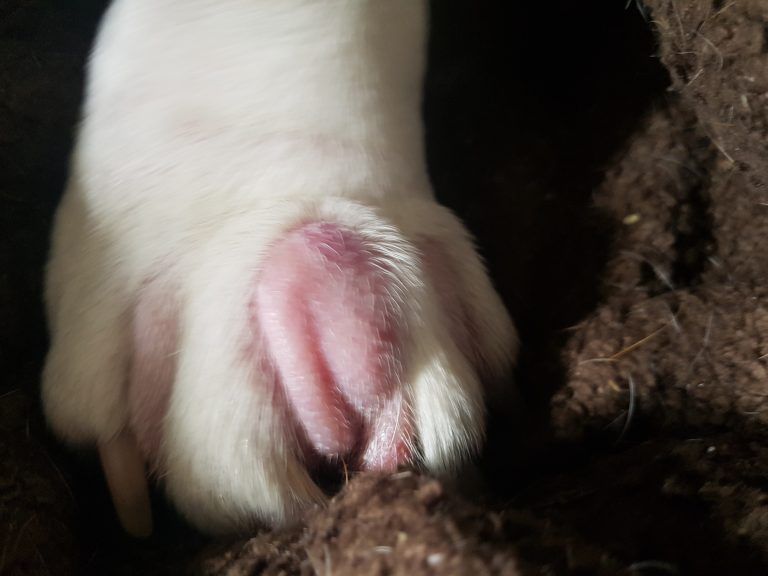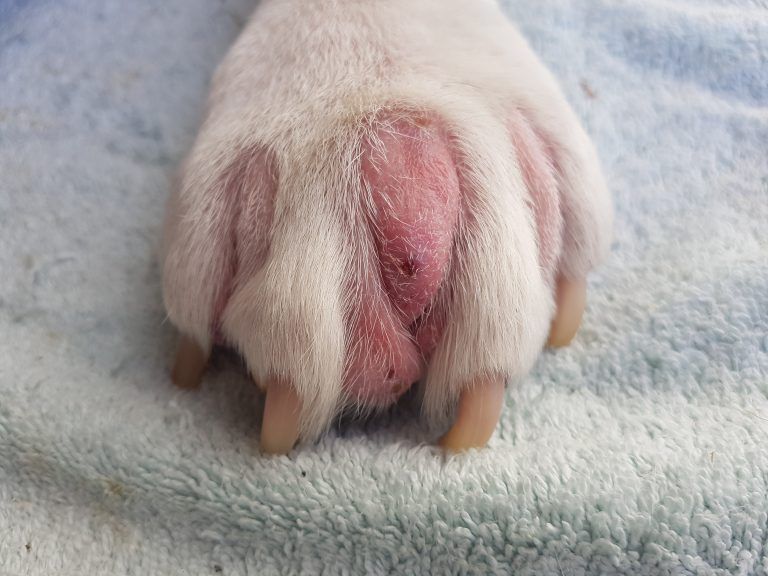Blog Layout
Recovery
Gemma Hodson • May 23, 2019
So Ron had been diagnosed with Calcinosis Cutis, a condition bought on by steroid use, as the cause of the growth on his neck. He was on 10mg of prednisone per day, which is a pretty low dose, but enough to do the damage none the less.
The trouble with steroids is that you cannot just stop giving them, you have to wean the dog off gradually. If you do you run the risk of causing organ damage, not to mention a huge spike in the allergic response that was being suppressed by them. Over the course of the next 2-3 weeks I dropped the dose from 2 tablets per day, to 1 and a half, then one ….. you get the idea. Despite the gradual reduction Ron’s feet flared up within days of coming off completely, Vince and I knew it would happen, he described it to me as steroids being the brakes to the immune system response, remove the brake and you get a flood as the immune system goes into overdrive. However the flare up wasn’t as bad as it could have been, that was so long that I controlled his environment and food and carried on using the remedies Vince prescribed. This leads me back to Ron’s other condition, Hyperthyroidism.
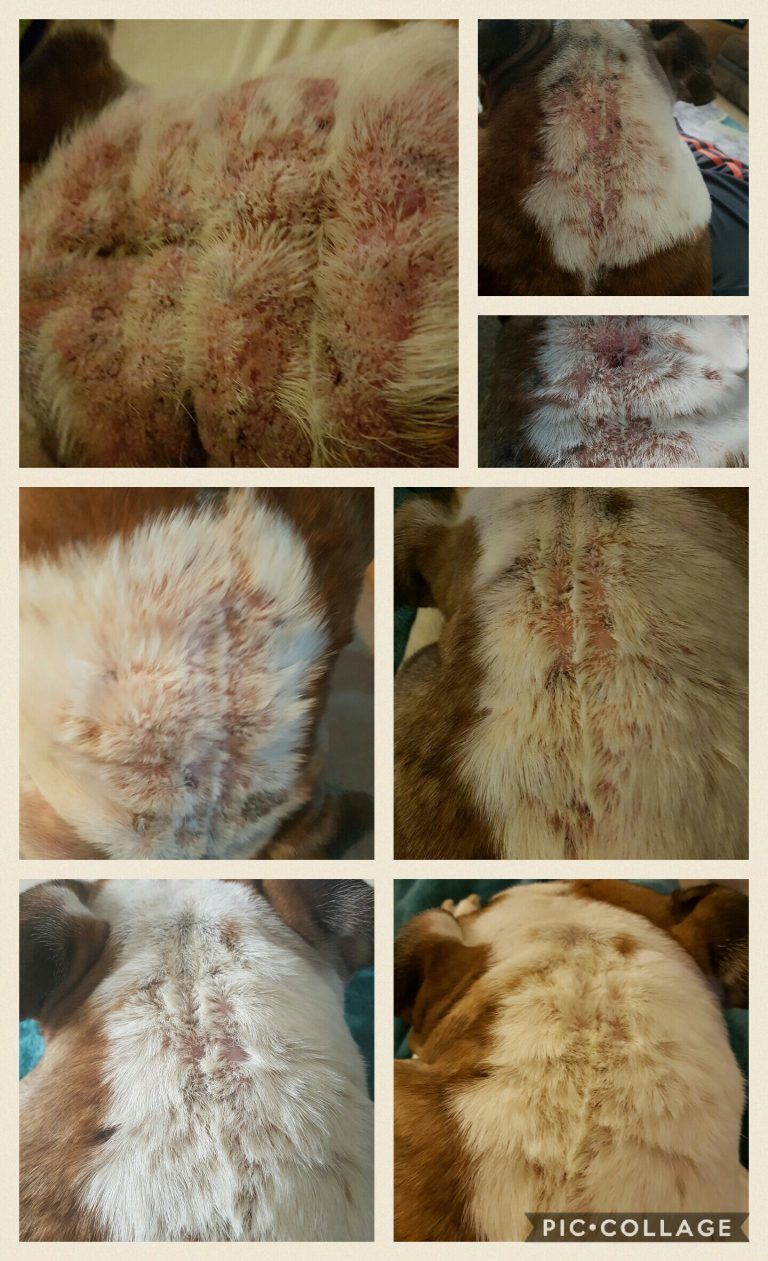
You may recall Jean Dodd suggested that the cause of the Hyperthyroidism in Ron could be down to him consuming meat containing Thyroid Tissue. As I explained my dog is RAW fed. He ate, at that time, 100% duck mince, which is minced up duck carcass, plus added veggies and supplements from me. I like many of you reading this thought that the thyroid gland is in the neck, I rang my food supplier and double checked that the necks were sold separately, they confirmed that this was the case. I went back to Jean Dodd with a list of what my dog was eating along with supplements. I started researching foods that could affect the thyroid function and found out that foods with high levels of Iodine can have an effect on the thyroid gland. Ron was on Kelp, which is one of the most Iodine rich foods you can get and Jean Dodd came back to me advising that I should drop this, Vince too agreed. Next on the list was Spirulina, Doesn’t have masses of Iodine in it but for the time being I was cutting that out too! But these supplements alone couldn’t have caused the Hyperthyroidism, there had to be something else I was missing. Then I started looking into where the thyroid gland was situated in birds, OMG it’s in the chest cavity! Even if the gland is removed the surrounding tissue can still cause a problem, I suppose it’s a bit like putting ginger biscuits into your biscuit tin with all your hobnobs, after a while the hobnobs start to taste of ginger biscuit. Ron had been eating minced duck carcass twice a day for nearly a year so this means I had to change his food, but Ron had food allergies so I was limited to what I could give him and food sensitivities can change over time meaning what he wasn’t allergic to at one point he may be now, I had to be careful. Back on the phone to the savior that is Vince the Vet and he advised that I get his food sensitivities tested again, but rather than take Ron for a blood test I would try a Nutriscan saliva test also to be sent to Hemopet in California. As luck would have it I had a kit that was given to me at the Natural Dog Conference the previous year. It is a really easy test that you can do yourself at home without the stress of taking your dog to a vet to be poked and prodded by needles. It consists of a cotton rope that you get your dog to chew on and get it really slobbery, you then put it in the container provided and pop it in the post. Simples. I will warn you now this test is extremely expensive, costing around £280. However, Ron is worth every penny I have spent so far, to date we are fairly close to the £2K mark which is what I paid for him as a puppy. Petplan at this point were being very difficult, slapping exclusions on his policy left right and centre and only paying out a fraction of each claim so I have footed the bill for about 80% of all his treatment so far myself. Anyway, it take 7 days to get to the US and the test takes 10 – 14 days, again I had to sit and wait.
Back onto Ron’s neck, a couple of weeks had passed and the progression had eased somewhat. He had started to get lumps on the underside of his neck but these were only small in comparison to the one on top. He was still reluctant to come out of his bed but he did seem brighter in himself, but he was still itchy. At one point he rubbed himself raw and barked for me a 5am, this had been the first night I had decided to sleep in my own bed and as soon as I heard him I knew something was wrong. I bathed it in salt water and rinsed it, then applied some Aloe Vera gel which seemed to ease his discomfort and take the heat out of it. I took a photo, and once it was a sensible hour I sent it on to Vince. I was due to take Ron up to see him in a few days and wondered if he could bring something to stop the itch. Vince was turning onto Ron’s personal Veterinarian, the poor guy must dread looking at his phone and seeing my name pop up. I have sent him some very odd photos of my dog over the last few months, from feet, to body, neck and ears, none of which are particularly pretty to look at and a strong stomach is usually required given the photo’s I have shared with you all. Vince again being very proactive would bring something with him in a few days. In the mean time other than slathering him in Aloe Vera there wasn’t much else I could do so I turned my attention onto encouraging him out of his cave.
I went to the local pet shop and chose the biggest toy they did, which wasn’t big at all if you are a 5 and a half stone bulldog. It resembled a skinned squirrel with a squeaky tennis ball for a head and a squeaker in the tail, I got back home with my present and walked into the kitchen. Ron stayed in his bed and just looked at me, utterly depressed. I detagged the squirrel and sat on the floor in front of him with it behind my back so he couldn’t see what it was. One squeak was all it took. The head popped up, the ears sprang to the top of his head and the sparkle came back in his eyes. Another squeak and he was up on his feet, I then showed him what I had bought and his little tail started wagging (as much as his little corkscrew tail could possibly wag, which isn’t a lot). I threw it behind me and off he went, gave it a good sniff, checked where the squeakers were by prodding it repeatedly with his nose, picked it up in his mouth and proceeded to parade around the living room snorting as he went. Thoroughly pleased as punch with his new favorite thing. He played with it for hours before my husband returned home. Noel was greeted by a very bouncy Bulldog, proudly showing him Mr Squirrel. This was the start of his recovery.
A few days later I made the trip up to Wolverhampton with Ron to see Vince at my mother in-laws house. Ron very politely greeted Vince at the front door and followed him into the sitting room. That dog waited until Vince had got settled, carefully watched as Vince retrieved his notes and pens, then walked over to give him what has become called being Ronned. It started with front paws in the lap and an insanely waggy tail, begging to be fussed, and finished with Ron on top of Vince. Notes crumpled and strewn about the place. Pens lost, glasses slobbered on, trousers covered in hair! If ever there was a way for a dog to say thank you I think Ron found it, and Vince was loving every second! After about 10 minutes Ron got back down on the floor looking thoroughly please with his efforts. The boy was back! Vince was amazed at how well in himself Ron now was. The first few meetings Ron had not wanted to interact with Vince at all which was not the dog I knew. Vince left after an hour, but not before giving me a remedy to help relieve Ron’s itch, 1 pill to be taken every 2-3 hours when required. This stuff was AMAZING and definitely did what it said it was going to do.

The next few weeks Ron’s hair started to grow back, he was now sporting what resembled Wayne Rooney’s hair transplant, slightly fuzzy and you really had to look hard to notice there was anything there at all. I was using TTouch on and around the area to not only help with the itch but to help with the healing by increasing blood flow to the area. I posted a photo of this small progress on my Facebook page which was instantly spotted by Sue Thane, another Happy Dog Training Co trainer. “Have you heard of Stinky Stuff?” Sue share the link and I immediately started to investigate. The burning question that came to me was, what on earth makes you call a product Stinky Stuff? I ordered it, I didn’t have anything else to lose, it was all natural so I thought I would give it a try. In the mean time the first part of Ron’s Nutriscan test was in.
Ron was intolerant to; White Fish, Barely, Egg, Lentil (peas), Oatmeal, Peanut, Quinoa, Rabbit, Salmon, Rice, & Sweet Potato. He was OK with; Wheat, Millet and Normal Potatoes & Soy but I was told to stay away from them. I would have to wait a further week for the Protein results to come in.
Ron’s neck was now looking like an old bristle brush with a lot of the bristles missing. However, the skin was looking a normal pink colour but it was still raised and rough textured. My parcel arrived from Sticky Stuff and I opened it with much anticipation. In the box came; 1 x pot of Stinky Stuff, 1 x bottle of Aloe Shampoo base and 1 x bottle of Carrier Oil. You mix Sticky stuff with the shampoo 50/50 and use it as an intensive treatment by bathing your dog in it and leaving it on for up to 10 minutes once a week or you could mix it with the carrier oil and use it as a rub targeted on the worst areas a few times a day. Sorry Ron ….. Its bath time! I opened the Shampoo base and poured 3 tablespoons into a container, then I opened the Stinky Stuff. WOW, now I know why they called it Stinky Stuff! That smell could out last religion. It got worse when you added it to wet dog smell. My house now smells distinctly of curried bulldog, and strong curried bulldog at that. In fact I had a very good friend of mine come round for a cuppa and a chat on the day I bathed him and she asked me if someone was ill and had an accident! The smell aside this stuff is fantastic. Not only does it help stop the itch, it repels fleas, ticks and mites, is an effective treatment for yeast infections AND promotes rapid hair regrowth. Within 2 weeks of using this on Ron, with a bath every Friday, the growth on his neck started to rapidly disappear. This has amazed both the breed specialist vet and Vince, who both thought I was going to have to get Ron operated on to remove it. Every day I look at it and every day there is noticeable improvement. I can live with the smell, because it is nothing short of miraculous.
The last of the allergy results were in. Lets just say it is easier for me to list the things he wasn’t allergic to than the things he was. So here goes …. Lamb. That was it. That was the grand sum of things he wasn’t allergic to! The dietary advice said that he should also be able to eat Kangaroo, Emu and Quail. Oh that’s EASY to get my hands on, I mean there are loads of Kangaroo’s hopping about in Tewkesbury, its renowned for them. Thanks Ron, you don’t make things easy for me. Lamb was ordered the same day but something told me this wasn’t going to be the end of things, I will leave that to my next blog in the new year.
But I cannot end this one without just a little bit of happiness. I am pleased to tell you that Ron has made a full recovery from Calcinocis Cutis. I no longer spend my nights on the kitchen floor with him, he is back to enjoying cuddles on the sofa. He is full of bounce and vigor and cheek. When all this started I never thought for one minute that Ron and I could possibly be any closer, but I was so wrong. He continues to teach and inspire me every day and he has opened may doors for me that I didn’t know existed. To some people he is just a dog, to me, he is my life and for all that has gone on and the stuff yet to come, I wouldn’t swap him for the world.
Merry Christmas to all my readers, and have a Happy New Year!!
Gem, Noel & Ron XXX
Share
Tweet
Share
Mail
More articles
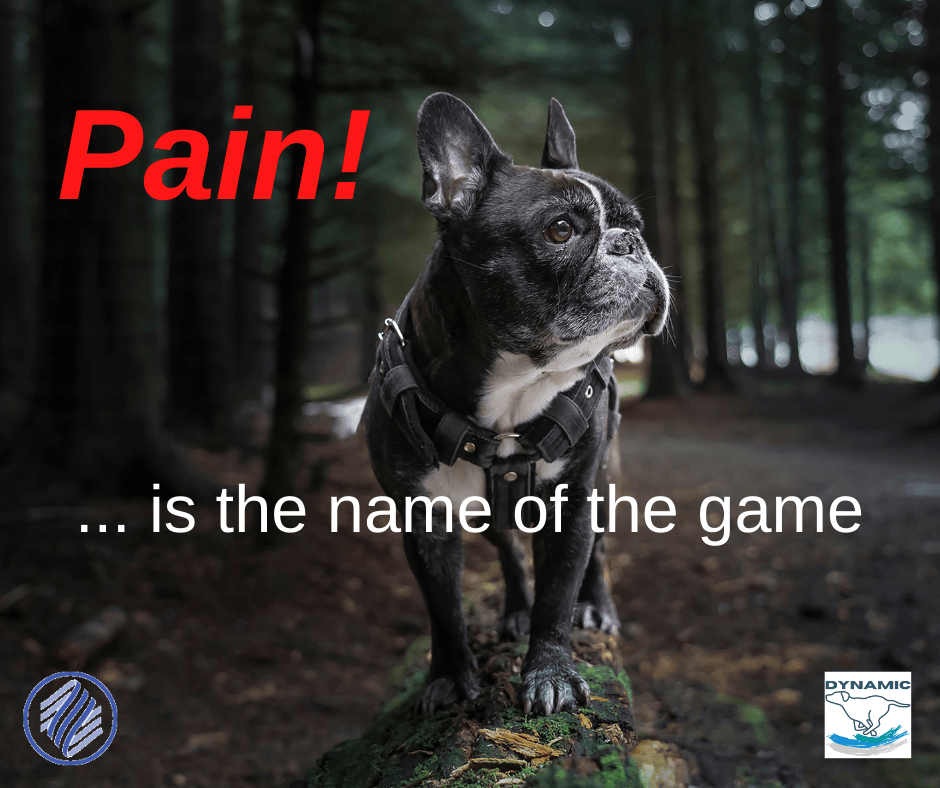
By Gemma Hodson
•
09 Sep, 2021
It’s everywhere at the moment and rightly so. However, the emphasis always seems to be that pain and discomfort creeps up on a dog, but this is not the case for all. In fact often the subtle signs were there long before the more obvious, but we were too blind to see. I want to highlight the dogs that have always been slow, lacked enthusiasm on a walk, the ones that have been labelled difficult, aggressive or reactive. The ones with the funny looking gait, who sit or stand slightly odd and ALWAYS HAVE.Just because they have always been like that, doesn’t mean it should be classed as normal and certainly doesn’t mean we should do nothing to help. I spent years at Hartpury College (UWE) studying horses where, even at a basic level, you get taught what made up a horse from the inside out, how each system worked, and why this was important information to know so we could keep our horses in optimum health for optimum performance and how all this impacts on behaviour. Not one system within the body operates on its own without it involving or impacting on another. It is exactly the same for dogs. A lot of the physical issues with dogs are developmental meaning that the condition developed as the dog was growing … right from puppyhood. Owners are unaware of how the health of their dog impacts on the emotional wellbeing and find it hard to make the connection between pain and behaviour. You only know, what you know and that’s fine, but there is a lot more we can do as dog professionals. We focus too much on the outward behaviour - even when we know there are contributing factors to it; diet, environment, past experience, equipment, handling and health (to name a few), but we are in a world where the physical affects the mental - pain affects behaviour. It is to a point that I have spent the last 5 years of self-employment working with those dogs and their humans. For those that don’t know about the study on Pains Affect’s on Behaviour in Cats & Dogs by Daniel Mills in Lincoln University - he found that approximately between 50 - 80% of dogs in the study that presented with behavioural issues had some form of undiagnosed pain. It is a rapidly growing concern. If you are a dog trainer or behaviourist and you think that you don’t need to know canine anatomy & physiology to do your job then sadly, you are missing so much of the dog in front of you. If you think that understanding how a dog moves and uses their body in day to day life is boring and has nothing to do with what you do then you are mistaken. Get Interested, start looking. The amount of time trainers and behaviourists spend with their clients compared to Vets is infinitely more! Those that do puppy and follow on classes, socialisation classes, hoopers, agility, 121 sessions, you could potentially help spot conditions before they negatively impact on the dog and help support the client alongside the Vet. Why are we waiting for a dog to go lame before we consider they might be in pain? I encourage you to learn about other things that will help you to understand what’s going on for a dog; crazy coat, body & facial tension, what healthy movement looks like so you can easily see the poor, weight shifting, loss of muscle mass and tone, good/poor conformation, breed specifics. Thankfully there are an ever growing number of my students that have graduated my course with this new knowledge and are changing the lives of dogs who were previously mis-labelled due to their behaviour. Those dogs are now on adequate pain meds, getting the support from a therapist such as a physio or hydro and the dog and human are getting relief. A little bit of information can go a long way in changing everything for a dog.
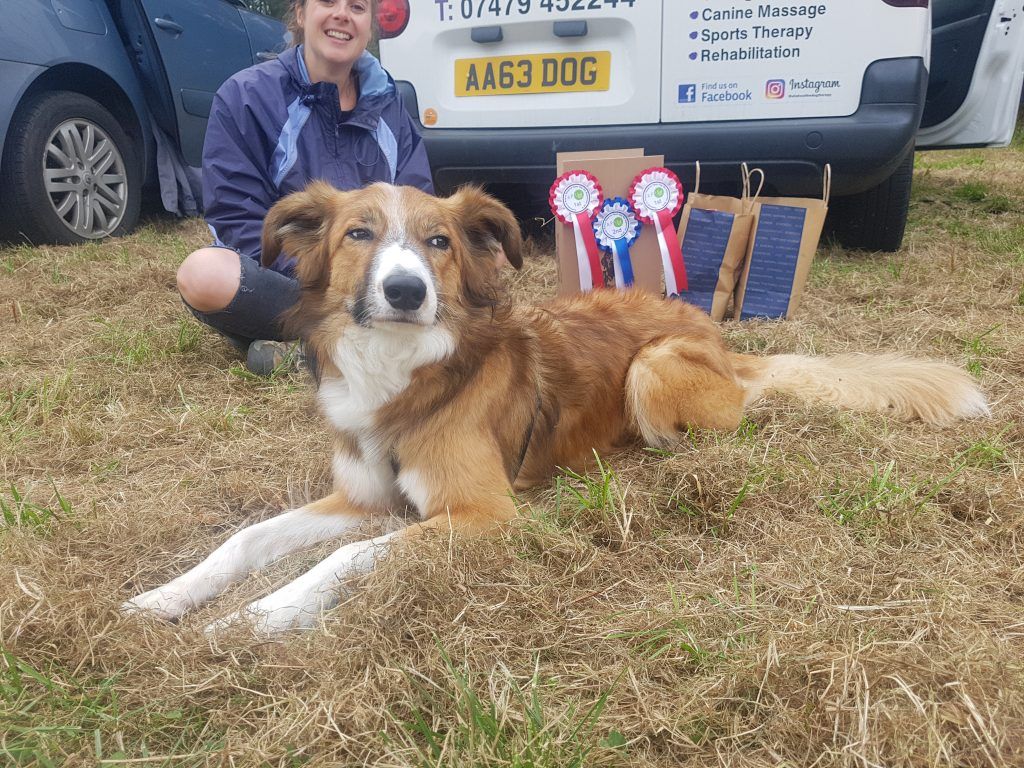
By Fay Thomas
•
23 May, 2019
I read all sorts of ‘helpful’ articles online that said if your dog ever shows aggressive tendencies you shouldn’t encourage them to play games like tug-of-war. This is false, it helps release a lot of tension and energy – in fact it’s Tag’s favourite game and he will try and play it all of his toys, even balls, he’s not fussy. I am going to be upfront about resource guarding – there is no magic cure, he will always resource guard however the items he guards are now fewer and we can go days and weeks without any guarding. But then we can have times where it feels like we’ve stepped backwards. At the time I’m finishing this off he has spent the whole week hiding my slippers in his bed. They key to resource guarding, and I learned this the hard way, is not to shout, chase after them, try and snatch the item out of their mouth etc. – none of that helps, in fact it makes the whole situation worse. You get stressed and irritated, the dog gets more possessive as it too is getting stressed. The key was playing swapsies with him – finding something to exchange for the stolen treasure. This could be a favourite toy or food. Most often food worked better for Tag when in the house, however if you put the food near him and then try to pick up the stolen item that he’d dropped next to it this was usually a fail. We had to start slowly, show him the food, get his interest in it and then throw it away from ourselves. This usually led to the item being dropped where he was stood so that he could go to the food – much safer in my opinion than a battle of reflexes, (and let’s be honest a dog will always win that!). For a whole it was a 2-person job as well – mostly because I was still petrified as to how he would react. Over time I started to add the word ‘drop’ and Tag started associating the link between the word, dropping an item and receiving food. Additionally we practiced ‘drop’ a lot at training with his toys so the word became associated with fun as well – he dropped the toy which meant it got thrown away for him to chase. I have to say this really became a beautiful skill and he passed his impulse control element of APDT with flying colours first time around, (not bad for a resource guarding dog).
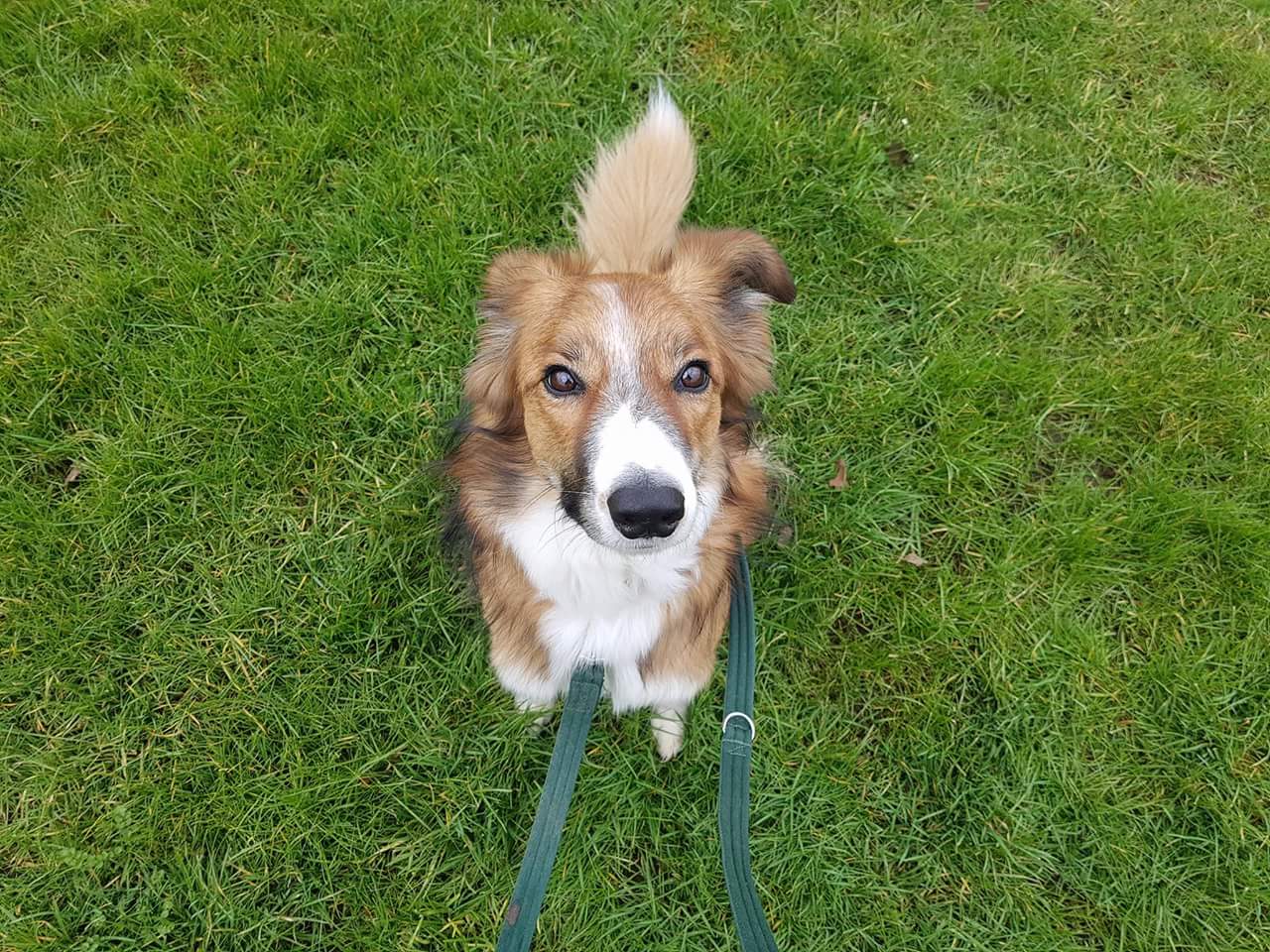
By Fay Thomas
•
23 May, 2019
But, this wasn’t his only issue so this issue will tell you about the other difficulties he also presented with. Before I do, I am going to apologise. I have always worked very hard not to use aversive training methods with Tag, reward based training has been the key, however, not all of the methods have quite followed the rule – so I am sorry. There were times where it felt like we had tried everything else and couldn’t think of any other solution. I do now however seek advice and enlist help to ensure future methods are up to date, reward based and force free. You only know what you know and at the time I thought I was doing the right thing I now know differently. Poop! So let’s get the unpleasant topic out of the way first – poop! Tag ate his own poop, he’d circle around, do his thing and before you knew it he was turning around and gobbling it up. Absolutely disgusting!! I am not sure why he did this so I did a lot of research online at the time. It may have been a lack of something in his diet so he was trying to re-digest the food (or something along those lines), another reason may have been having his nose rubbed in his own faeces whilst he was being house-trained by his first owners or finally it may have been that having lived in a kennel for a month and therefore his poop not being cleared up straight away he got into a habit of eating it to keep his ‘home’ clean. Now I am absolutely positive that there were much better ways of handling this but in the end my ex resorted to following Tag around the garden when he was let outside and sprinkling chilli powder onto his poop before he had chance to eat it. When Tag did try to pick it up he got a bit of a shock and put it straight back down. After a short while Tag stopped trying to eat his own poop and I’m pleased to say he hasn’t ever tried to take that habit back up. Car Chasing Another habit Tag had was car chasing. You would be quite happily walking down the street towards the field when a car would drive past and suddenly Tag yanks the lead so hard to chase it you almost go flying. If you didn’t let him chase the car he would just try again, and again, and again! Tag absolutely loves walks so whenever he chased a car I would just stop walking, sometimes I would even sit in the middle of the pavement, and we would stay there until several cars had gone past and he hadn’t reacted. As a reward we would start walking again. I’d love to say I brought clicker training into this and lots of tasty food but Tag is so excited by the world he mostly couldn’t care less what food you have in your pocket when you leave the house. Eventually Tag stopped chasing cars and I could walk down the street without fear of being pulled into a road. Now and again he might try and jump towards a car but it seems he only does it these days if he is particularly tense or we’ve had some pretty extreme weather – cars make a lot more noise when they are on a wet road.
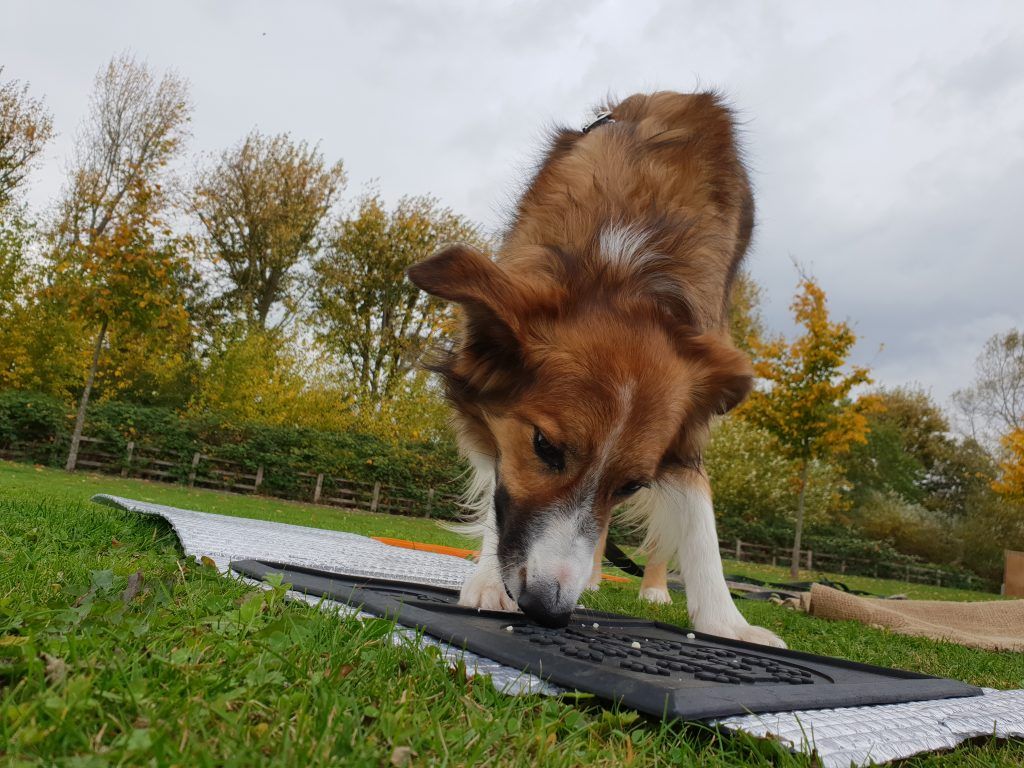
By Fay Thomas
•
23 May, 2019
I wanted to be a responsible owner so even before he had his first night in the house I was calling dog training companies to help him learn basic obedience skills. This wasn’t as easy as it might sound. A lot of company’s offer puppy training classes and although he was technically still a puppy he was considered too old to participate. Fortunately I found ‘Naturally Clever Canines’ who held classes for ‘Beginner’s Training’ – the age of the dog didn’t matter but it was aimed at Dog’s who had never been trained. Perfect!! And well, both Helen and Correna were and still are fantastic, so supportive and were so understanding of Tag’s background. There were definitely things that Tag struggled with when working towards his ‘Good Companion Awards’ – notably body touching – but both of them worked with him at his own pace, we took it step-by-step and week-by-week and whenever he showed signs of it all being a bit too much, we stopped. He passed every test and we have all of the rosettes to prove it! If I could give you any advice for bonding with your dog I would recommend going to a Training Class. I have always worked full-time from the day Tag came home and the least I could give him was 1 hour of my undivided attention each week. He got 1 hour in a local community centre learning new things with me, we learned together without the distractions that come with being at home, (cooking dinner, the housework, something on TV – you know what it’s like). Also, I can’t say it enough – patience, understanding and don’t give up!
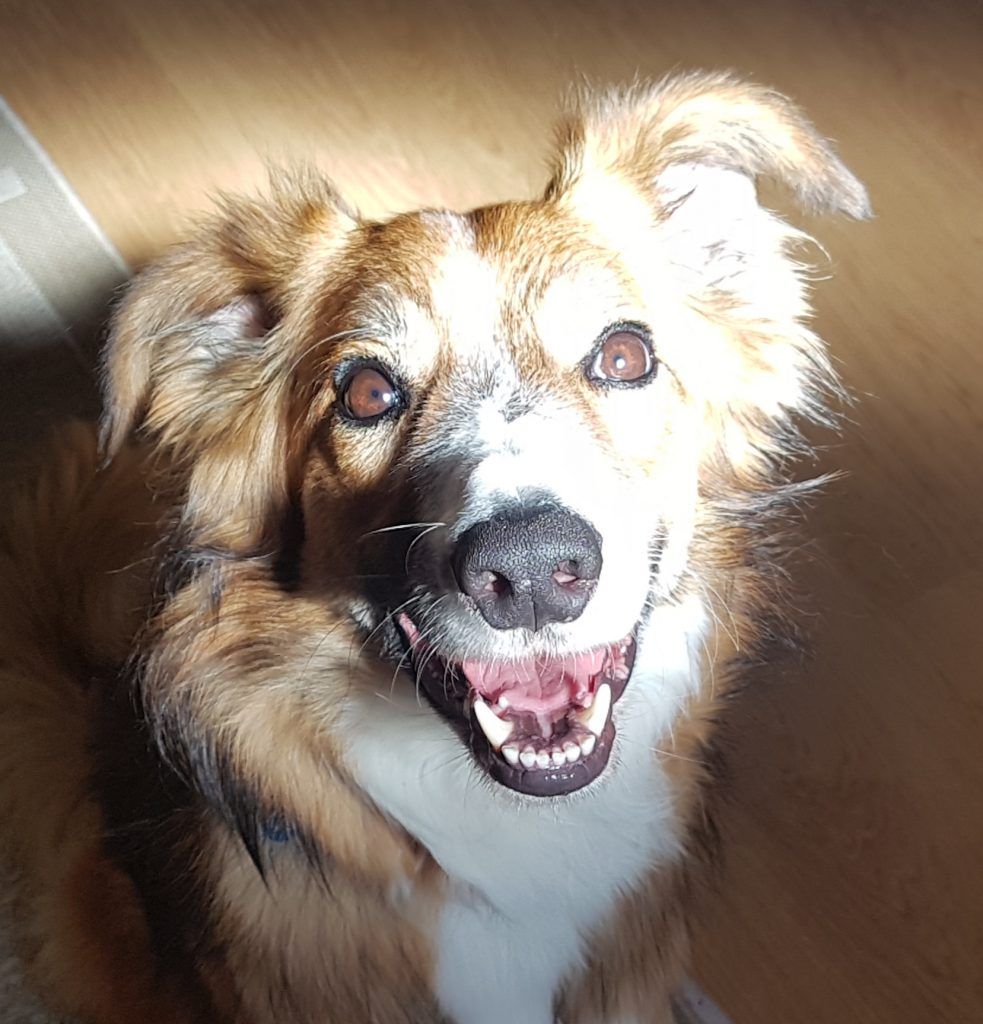
By Fay Thomas
•
23 May, 2019
The story of moving house somewhere that would ‘consider pets’, the fight to get landlord permission is a whole other story but the Estate Agent said he didn’t think it would be a problem when I looked around the house…… so the search for a dog began. Now I didn’t care what breed of dog I got my only requirements were that I didn’t get something tiny but equally I needed to be realistic, not something too big because well it’s not like I had a huge house or a huge garden. Also I was pretty set on re-homing a rescue dog, because, well, anyone can buy a puppy right? I wanted to give a dog a chance, that for no reason of their own, had been given up by their previous owners. Where I live the local Animal Shelter is FULL of Staffordshire Bull Terriers. Personally, I think they are cute but my now ex-partner was adamant that he did not want a Staffy. He was also pretty adamant he didn’t want a short-haired dog. Now came the dilemma, he wanted a Husky or a Collie – well you can see from the pictures he got his own way – Tag is most definitely a Collie!
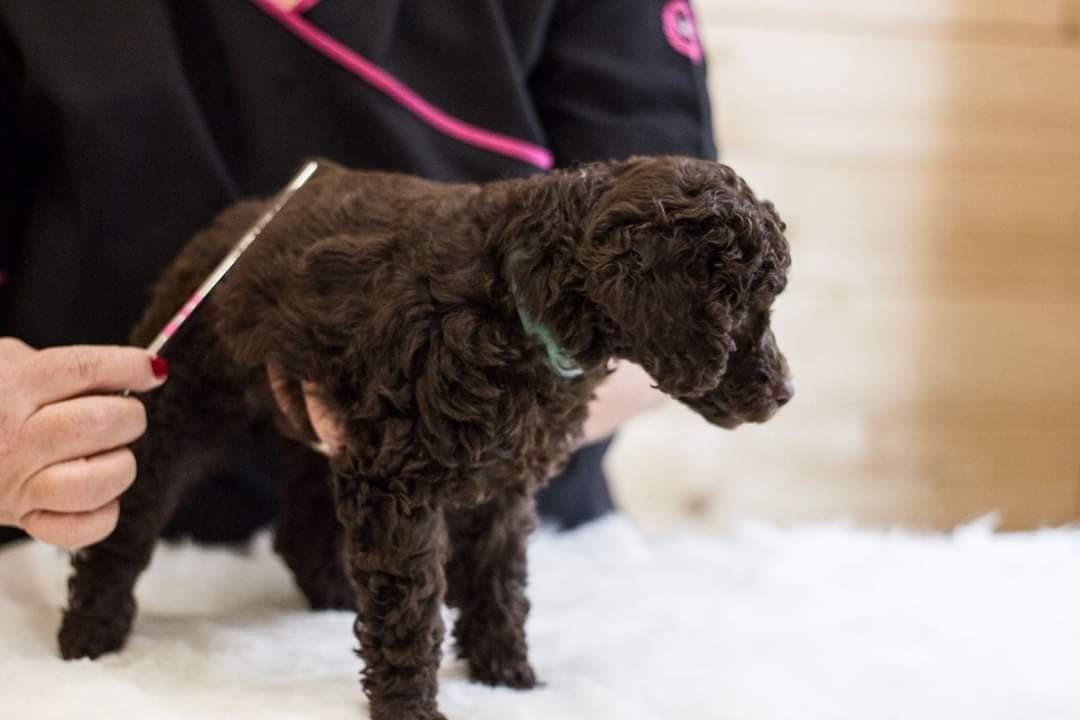
By Sue Williamson
•
23 May, 2019
Firstly, grooming can become a good bonding opportunity for you and your dog, especially if you build up confidence and trust gently from a very young age. For some owners the issue isn’t that they don’t know how to brush their dog correctly, it is that they go straight in and expect to be able to brush their dog head to tail in one go, then make it into a battle when their dog doesn’t like it, tries to bite the brush or hand, or runs away and hides at the sight of a brush. There is help at hand to overcome these issues, Gemma (All About the Dog – Therapy) will be happy to help with this, or attend one of my workshop where I can teach you a number of trust based techniques to build up confidence. Grooming is also a good opportunity for you to check over your dog for lumps, bumps, cuts and grazes, and those nasty grass seeds, ticks and fleas!! Short hair dogs, such as labradors, staffies, etc, will also benefit from regular brushing. I personally love the Kong Zoom Groom for short haired breeds. For those dogs with longer coats, regular grooming with a good quality slicker brush will enable you to keep your dogs coat free of mats.
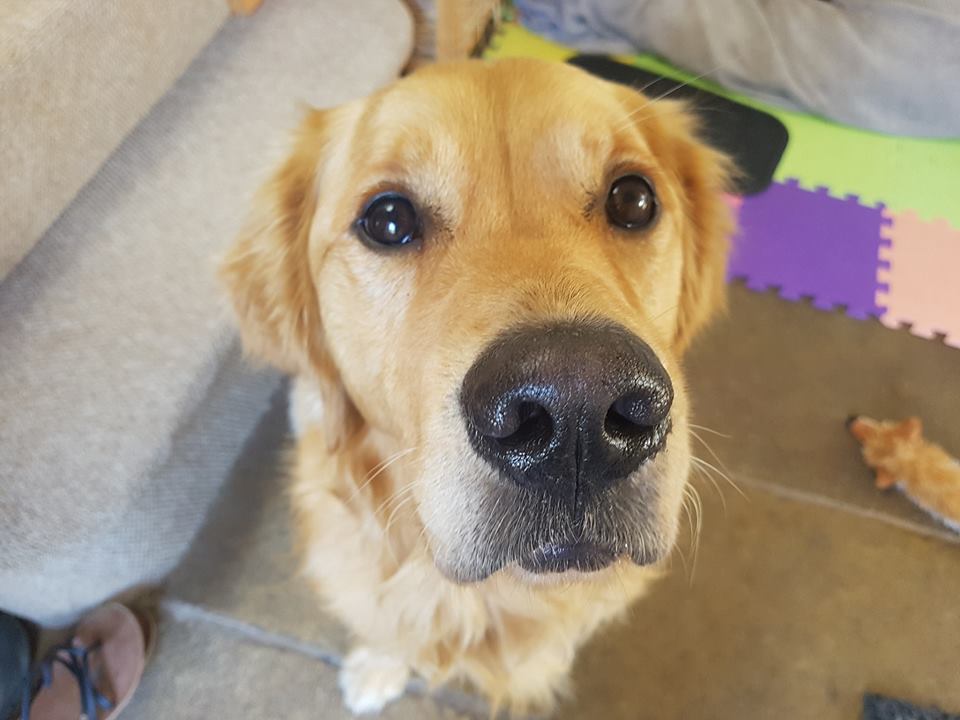
By Gemma Hodson
•
23 May, 2019
After performing a superficial muscle palpation on Milo I could find no issue with his back, however he did sit down rather quickly and he turned to look at my hand when I went inside the top of his left hind limb. On further investigation I found quite a bit of heat and swelling right up deep inside his groin (iliopsoas muscle), where it felt like a bag of marbles. Tearing of the iliopsoas muscles is usually the result of excessive stretching consistent with that of splaying of the legs due to slipping or high energy games such as chasing after a tennis ball, jumping off high objects, excessive training or play with other dogs. Tearing of this muscle can be extremely painful and can cause lameness. This definitely fitted what Milo had and was experiencing. As part of my training/coursework case studies I treated Milo using remedial massage on 4 separate occasions following his injury to which he dramatically improved and returned to his normal self. Four months later the injury reoccurred although not to the same extent. Newly qualified in Canine Sports Therapy I returned to reassess Milo. He was lame again on his left hind and not fully weight bearing. As well as the issues with the iliopsoas muscle returning his hamstrings were now also tight. There was also significant muscle wastage of the biceps femoris, but what struck me the most was the coat change over both of his stifle joints. What was usually a sleek glossy deep golden in colour coat had become light fluffy and fuzzy in texture – this was something my TTouch Practitioner training was telling me to make a note and investigate further!
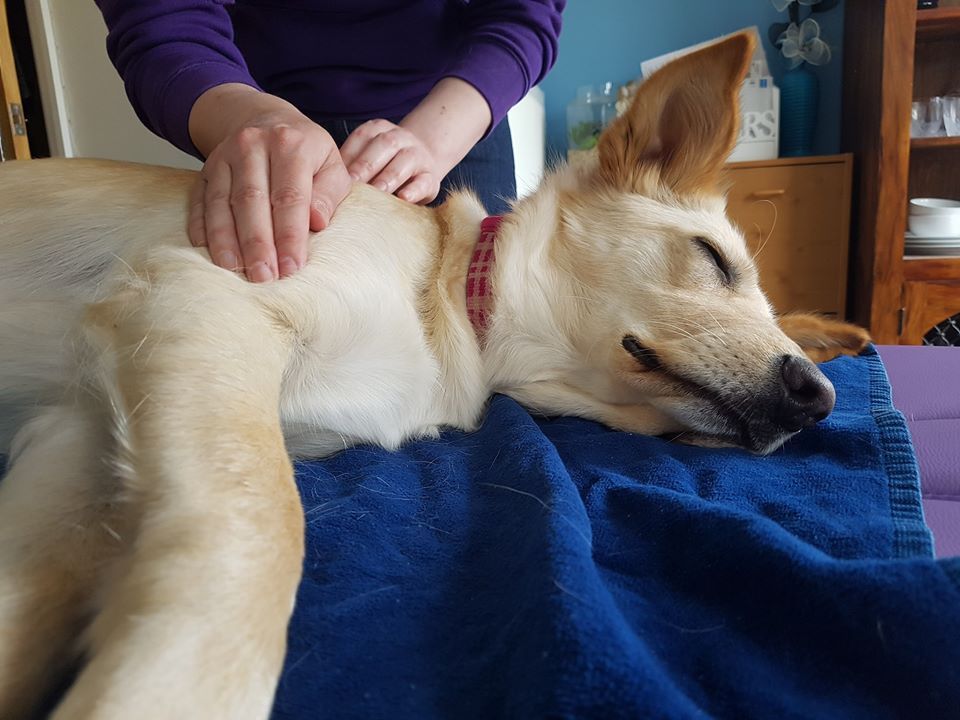
By Gemma Hodson
•
23 May, 2019
What is Vet Consent? If you want your dog to undergo physiotherapy, hydrotherapy, massage therapy, sports therapy, galen therapy or acupuncture the therapist must obtain vet consent before treatment can begin. It is a legal requirement for a therapist in order to treat your pet and relates directly to the Veterinary Surgeons Act 1966 and Exempt Order 2015. Why should I obtain Vet Consent? Other than it being law it is a way for your pets therapist to ascertain if there are any reasons as to why treatment should be avoided, also known as contraindicated. This could be a simple as the vet advising care should be taken in certain areas due to surgery or injury, or that the treatment should be avoided altogether in the likelihood the animals condition is exacerbated for example if your dog is taking certain types of medication or has a serious illness.
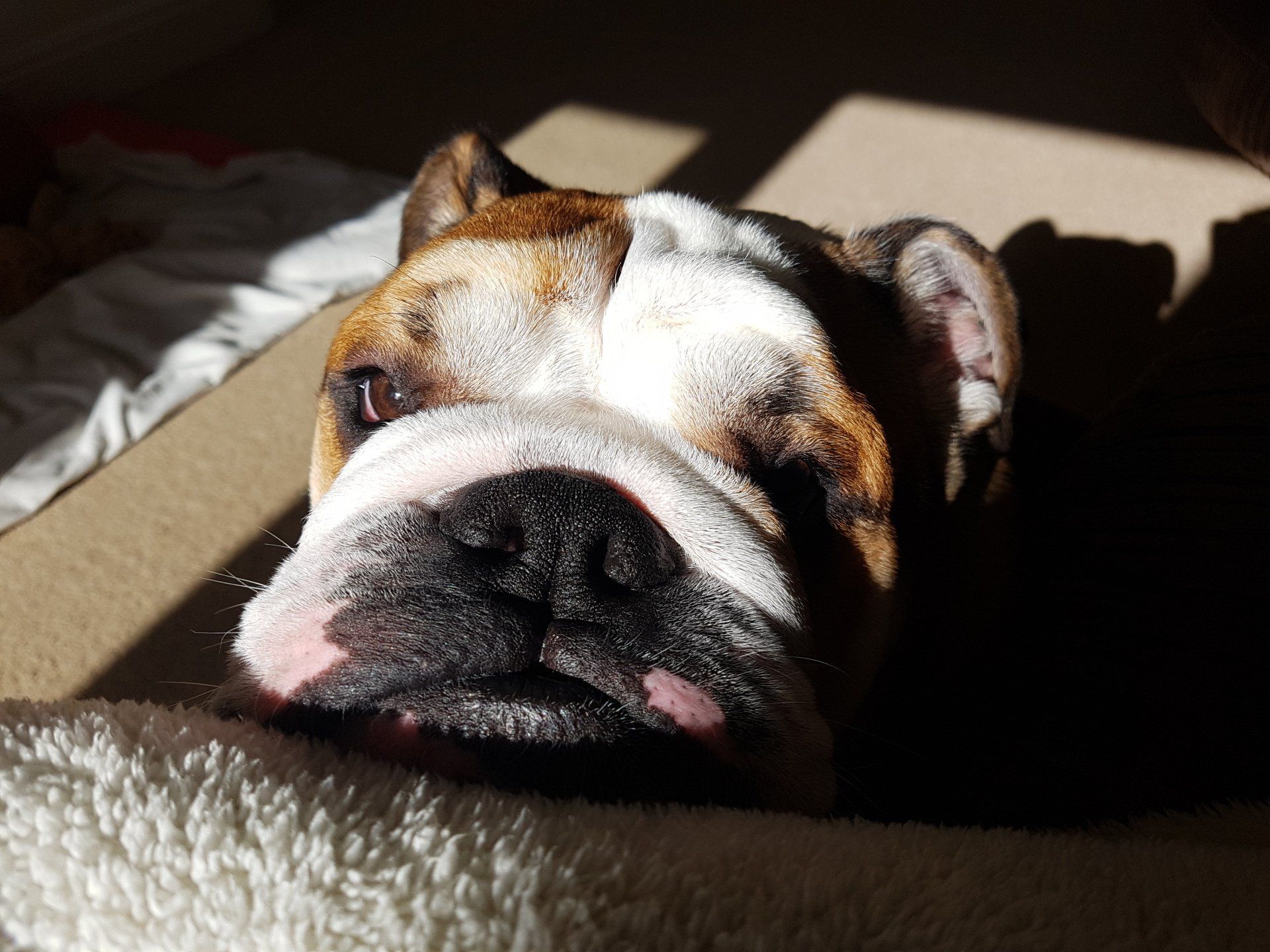
By Gemma Hodson
•
23 May, 2019
5 weeks spent sleeping on the kitchen floor so Ron didn’t have to go through this alone. 5 weeks of watching my dog give up on life. 5 weeks of dreading what tomorrow would bring. Reliving what happened brought on an anxiety attack, which surprised me as during the actual time Ron’s condition was developing I didn’t have one …. I got Ron safely home and put his bloods in my fridge. Fired up the laptop and found the Hemopet website to see how I needed to send them. They needed to go to California and therefore I should be sending serum! Bum, I had left Wolverhampton with unspun blood. Now I am very lucky to have some amazing friends, one of which I work alongside on the Reactive Dogs Course at The Happy Dog Training Company in Tewkesbury. Kim Hawley is a Vet Nurse and one quick text to her the following morning and I was back in my car heading to her place of work where she would spin Ron’s blood to get the serum I needed. Serum is viable at room temperature for about 2 weeks so it was soon in the post winging its way to the US. I just had to sit and wait. Now I should explain that due to Ron’s symptoms we were thinking he had Hypothyroidism. A condition that for a number of reasons means that the Thyroid Gland doesn’t produce enough of the hormone. Ron was looking soft and podgy and losing hair on top of the skin issues of recurring abscess in the paws and tail and now this strange thing on the back of his neck. Cushings was also mentioned by Vince as a possible cause of Ron’s symptoms so I would also get his urine tested to check his cortisol levels later in the week. Too high and this could be the answer and one I didn’t want. Skip forwards a week, the serum was well on its way to California. The thing on Ron’s neck was now 4 inches long by 2 inches wide and had the appearance of a 3rd degree burn! Ron has a Mohican that runs from the back of his head slap bang down his crest to his withers and this thing was following this line. Back on the phone to the breed specialist vet who was now thinking this was a skin infection. Ron wasn’t letting me nor anyone else touch it, it looked really sore. He had also started to get little bite like lumps pebble dashing both sides, down his legs and on his testicles. One of his other symptoms I had forgotten to mention was Ron’s decreasing desire for any physical contact. He used to love a cuddle on the sofa as a puppy but the older he grew and the further down this terrible journey he went the less he wanted to join us on the sofa. The breed specialist wanted to watch and wait for a few days to see what happened with his neck and I would carry on bathing it and applying good old Sudocrem. Vince however was very pro-active. Out of respect for Vince I am not going to divulge what remedies he prescribed my dog, but I can tell you all of which were to help stabilize Ron’s Immune System as after all this was the major factor to his troubles. Once we had started to stabilize the immune system we could then slowly start dropping the steroids down. Until then he had to stay on 10mg a day.
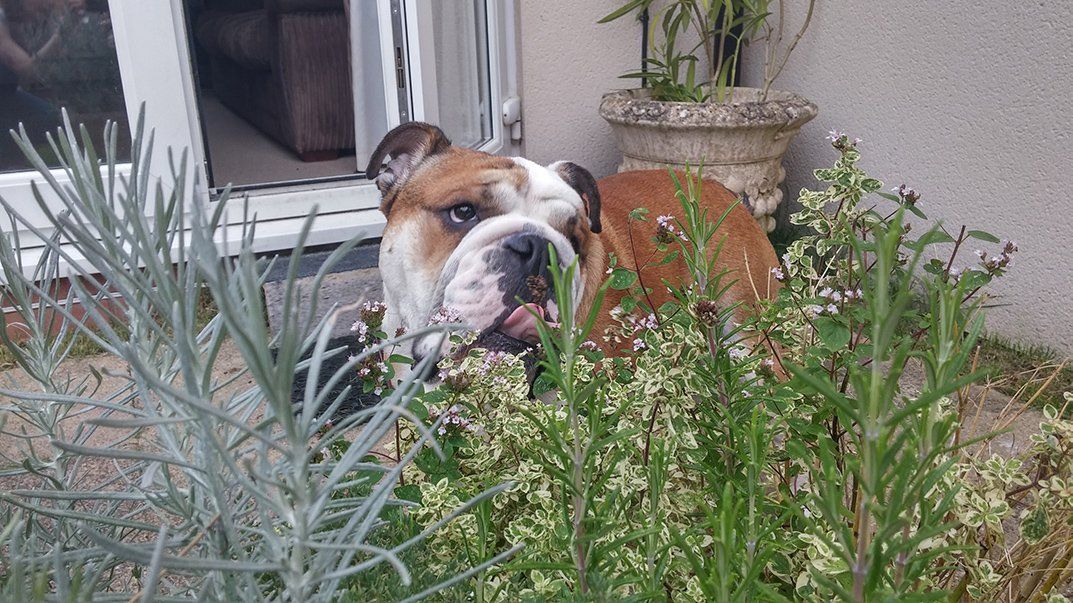
By Gemma Hodson
•
23 May, 2019
To look at you could not want for a better example of the breed, he has wide nostrils with no soft pallet issues that cause compromised breathing, his nose is not pushed up into his skull. His eyes are clear and free from the gland issue known as cherry eye and his lids do not droop. He has a level top line and does not have a short, squat appearance with rump higher than the shoulders. He is in proportion. He would quite happily go for an hour long walk, where he would run and keep up with Labradors and spaniels without faltering and still want to be played with vigorously when he got home. He is massively intelligent, has progressed through puppy courses all the way through his Kennel Club Good Citizens awards and has done advanced training called Helpful Hounds where he learnt to close doors, pull my coat off and switch lights on and off. Not the stereotypical “stubborn” Bulldog that these dogs are renowned for being. Personally I feel if you find the right technique (reward based and force free) any dog can be trained. However, my dog has been on such an awful journey these last 18 months that no dog should have had to suffer. It started when he was approximately 6 months old with what we thought were Inter-digital Cysts. Inter digital Cysts is a condition known to short furred dogs where the hair follicle is forced back up into the skin on the underside of the paw resulting in a lump to form in between the webbing of the toes on the upper side. After many home remedies, lemon juice, Epsom salt soaks etc which had little effect I then took my dog to the local vet. I was told “he is a Bulldog, it’s his breed” given a course of steroids and sent on our way. After the course of steroids finished the problem came back, I returned to the vet to be told yet again “it’s his breed” and sent on my way with yet more steroids. I am not one to sit about and take a vets word for things. I am a control freak and need to know what the problem is, why it was happening and what I can do to resolve it. “It’s his breed”! OK let’s find a breed specialist, after all you wouldn’t go to the chiropodist to have a filling, so I located THE man to go to and at the age of 18 months I took Ron to Wolverhampton, which isn’t far from me luckily, to meet the infamous breed specialist vet. 8 months of being on and off steroids and by December 2015 my dog was still nowhere to being relieved of his problem and the list of symptoms where now getting longer and his paw lumps bigger and debilitating. I had tried many different diets, kibble and raw. I had started to turn to the more holistic approach due to perusing my own dream to be a Tellington TTouch Practitioner, and found myself sat at a lecture by a holistic vet from Bath. Alarm bells started to ring for me and after discussion with the holistic vet I went back to the breed specialist vet and pushed for allergy tests and I also wanted his Thyroid checked by Hemopet.

By Gemma Hodson
•
09 Sep, 2021
It’s everywhere at the moment and rightly so. However, the emphasis always seems to be that pain and discomfort creeps up on a dog, but this is not the case for all. In fact often the subtle signs were there long before the more obvious, but we were too blind to see. I want to highlight the dogs that have always been slow, lacked enthusiasm on a walk, the ones that have been labelled difficult, aggressive or reactive. The ones with the funny looking gait, who sit or stand slightly odd and ALWAYS HAVE.Just because they have always been like that, doesn’t mean it should be classed as normal and certainly doesn’t mean we should do nothing to help. I spent years at Hartpury College (UWE) studying horses where, even at a basic level, you get taught what made up a horse from the inside out, how each system worked, and why this was important information to know so we could keep our horses in optimum health for optimum performance and how all this impacts on behaviour. Not one system within the body operates on its own without it involving or impacting on another. It is exactly the same for dogs. A lot of the physical issues with dogs are developmental meaning that the condition developed as the dog was growing … right from puppyhood. Owners are unaware of how the health of their dog impacts on the emotional wellbeing and find it hard to make the connection between pain and behaviour. You only know, what you know and that’s fine, but there is a lot more we can do as dog professionals. We focus too much on the outward behaviour - even when we know there are contributing factors to it; diet, environment, past experience, equipment, handling and health (to name a few), but we are in a world where the physical affects the mental - pain affects behaviour. It is to a point that I have spent the last 5 years of self-employment working with those dogs and their humans. For those that don’t know about the study on Pains Affect’s on Behaviour in Cats & Dogs by Daniel Mills in Lincoln University - he found that approximately between 50 - 80% of dogs in the study that presented with behavioural issues had some form of undiagnosed pain. It is a rapidly growing concern. If you are a dog trainer or behaviourist and you think that you don’t need to know canine anatomy & physiology to do your job then sadly, you are missing so much of the dog in front of you. If you think that understanding how a dog moves and uses their body in day to day life is boring and has nothing to do with what you do then you are mistaken. Get Interested, start looking. The amount of time trainers and behaviourists spend with their clients compared to Vets is infinitely more! Those that do puppy and follow on classes, socialisation classes, hoopers, agility, 121 sessions, you could potentially help spot conditions before they negatively impact on the dog and help support the client alongside the Vet. Why are we waiting for a dog to go lame before we consider they might be in pain? I encourage you to learn about other things that will help you to understand what’s going on for a dog; crazy coat, body & facial tension, what healthy movement looks like so you can easily see the poor, weight shifting, loss of muscle mass and tone, good/poor conformation, breed specifics. Thankfully there are an ever growing number of my students that have graduated my course with this new knowledge and are changing the lives of dogs who were previously mis-labelled due to their behaviour. Those dogs are now on adequate pain meds, getting the support from a therapist such as a physio or hydro and the dog and human are getting relief. A little bit of information can go a long way in changing everything for a dog.

By Fay Thomas
•
23 May, 2019
I read all sorts of ‘helpful’ articles online that said if your dog ever shows aggressive tendencies you shouldn’t encourage them to play games like tug-of-war. This is false, it helps release a lot of tension and energy – in fact it’s Tag’s favourite game and he will try and play it all of his toys, even balls, he’s not fussy. I am going to be upfront about resource guarding – there is no magic cure, he will always resource guard however the items he guards are now fewer and we can go days and weeks without any guarding. But then we can have times where it feels like we’ve stepped backwards. At the time I’m finishing this off he has spent the whole week hiding my slippers in his bed. They key to resource guarding, and I learned this the hard way, is not to shout, chase after them, try and snatch the item out of their mouth etc. – none of that helps, in fact it makes the whole situation worse. You get stressed and irritated, the dog gets more possessive as it too is getting stressed. The key was playing swapsies with him – finding something to exchange for the stolen treasure. This could be a favourite toy or food. Most often food worked better for Tag when in the house, however if you put the food near him and then try to pick up the stolen item that he’d dropped next to it this was usually a fail. We had to start slowly, show him the food, get his interest in it and then throw it away from ourselves. This usually led to the item being dropped where he was stood so that he could go to the food – much safer in my opinion than a battle of reflexes, (and let’s be honest a dog will always win that!). For a whole it was a 2-person job as well – mostly because I was still petrified as to how he would react. Over time I started to add the word ‘drop’ and Tag started associating the link between the word, dropping an item and receiving food. Additionally we practiced ‘drop’ a lot at training with his toys so the word became associated with fun as well – he dropped the toy which meant it got thrown away for him to chase. I have to say this really became a beautiful skill and he passed his impulse control element of APDT with flying colours first time around, (not bad for a resource guarding dog).

By Fay Thomas
•
23 May, 2019
But, this wasn’t his only issue so this issue will tell you about the other difficulties he also presented with. Before I do, I am going to apologise. I have always worked very hard not to use aversive training methods with Tag, reward based training has been the key, however, not all of the methods have quite followed the rule – so I am sorry. There were times where it felt like we had tried everything else and couldn’t think of any other solution. I do now however seek advice and enlist help to ensure future methods are up to date, reward based and force free. You only know what you know and at the time I thought I was doing the right thing I now know differently. Poop! So let’s get the unpleasant topic out of the way first – poop! Tag ate his own poop, he’d circle around, do his thing and before you knew it he was turning around and gobbling it up. Absolutely disgusting!! I am not sure why he did this so I did a lot of research online at the time. It may have been a lack of something in his diet so he was trying to re-digest the food (or something along those lines), another reason may have been having his nose rubbed in his own faeces whilst he was being house-trained by his first owners or finally it may have been that having lived in a kennel for a month and therefore his poop not being cleared up straight away he got into a habit of eating it to keep his ‘home’ clean. Now I am absolutely positive that there were much better ways of handling this but in the end my ex resorted to following Tag around the garden when he was let outside and sprinkling chilli powder onto his poop before he had chance to eat it. When Tag did try to pick it up he got a bit of a shock and put it straight back down. After a short while Tag stopped trying to eat his own poop and I’m pleased to say he hasn’t ever tried to take that habit back up. Car Chasing Another habit Tag had was car chasing. You would be quite happily walking down the street towards the field when a car would drive past and suddenly Tag yanks the lead so hard to chase it you almost go flying. If you didn’t let him chase the car he would just try again, and again, and again! Tag absolutely loves walks so whenever he chased a car I would just stop walking, sometimes I would even sit in the middle of the pavement, and we would stay there until several cars had gone past and he hadn’t reacted. As a reward we would start walking again. I’d love to say I brought clicker training into this and lots of tasty food but Tag is so excited by the world he mostly couldn’t care less what food you have in your pocket when you leave the house. Eventually Tag stopped chasing cars and I could walk down the street without fear of being pulled into a road. Now and again he might try and jump towards a car but it seems he only does it these days if he is particularly tense or we’ve had some pretty extreme weather – cars make a lot more noise when they are on a wet road.

By Fay Thomas
•
23 May, 2019
I wanted to be a responsible owner so even before he had his first night in the house I was calling dog training companies to help him learn basic obedience skills. This wasn’t as easy as it might sound. A lot of company’s offer puppy training classes and although he was technically still a puppy he was considered too old to participate. Fortunately I found ‘Naturally Clever Canines’ who held classes for ‘Beginner’s Training’ – the age of the dog didn’t matter but it was aimed at Dog’s who had never been trained. Perfect!! And well, both Helen and Correna were and still are fantastic, so supportive and were so understanding of Tag’s background. There were definitely things that Tag struggled with when working towards his ‘Good Companion Awards’ – notably body touching – but both of them worked with him at his own pace, we took it step-by-step and week-by-week and whenever he showed signs of it all being a bit too much, we stopped. He passed every test and we have all of the rosettes to prove it! If I could give you any advice for bonding with your dog I would recommend going to a Training Class. I have always worked full-time from the day Tag came home and the least I could give him was 1 hour of my undivided attention each week. He got 1 hour in a local community centre learning new things with me, we learned together without the distractions that come with being at home, (cooking dinner, the housework, something on TV – you know what it’s like). Also, I can’t say it enough – patience, understanding and don’t give up!

By Fay Thomas
•
23 May, 2019
The story of moving house somewhere that would ‘consider pets’, the fight to get landlord permission is a whole other story but the Estate Agent said he didn’t think it would be a problem when I looked around the house…… so the search for a dog began. Now I didn’t care what breed of dog I got my only requirements were that I didn’t get something tiny but equally I needed to be realistic, not something too big because well it’s not like I had a huge house or a huge garden. Also I was pretty set on re-homing a rescue dog, because, well, anyone can buy a puppy right? I wanted to give a dog a chance, that for no reason of their own, had been given up by their previous owners. Where I live the local Animal Shelter is FULL of Staffordshire Bull Terriers. Personally, I think they are cute but my now ex-partner was adamant that he did not want a Staffy. He was also pretty adamant he didn’t want a short-haired dog. Now came the dilemma, he wanted a Husky or a Collie – well you can see from the pictures he got his own way – Tag is most definitely a Collie!

By Sue Williamson
•
23 May, 2019
Firstly, grooming can become a good bonding opportunity for you and your dog, especially if you build up confidence and trust gently from a very young age. For some owners the issue isn’t that they don’t know how to brush their dog correctly, it is that they go straight in and expect to be able to brush their dog head to tail in one go, then make it into a battle when their dog doesn’t like it, tries to bite the brush or hand, or runs away and hides at the sight of a brush. There is help at hand to overcome these issues, Gemma (All About the Dog – Therapy) will be happy to help with this, or attend one of my workshop where I can teach you a number of trust based techniques to build up confidence. Grooming is also a good opportunity for you to check over your dog for lumps, bumps, cuts and grazes, and those nasty grass seeds, ticks and fleas!! Short hair dogs, such as labradors, staffies, etc, will also benefit from regular brushing. I personally love the Kong Zoom Groom for short haired breeds. For those dogs with longer coats, regular grooming with a good quality slicker brush will enable you to keep your dogs coat free of mats.

By Gemma Hodson
•
23 May, 2019
After performing a superficial muscle palpation on Milo I could find no issue with his back, however he did sit down rather quickly and he turned to look at my hand when I went inside the top of his left hind limb. On further investigation I found quite a bit of heat and swelling right up deep inside his groin (iliopsoas muscle), where it felt like a bag of marbles. Tearing of the iliopsoas muscles is usually the result of excessive stretching consistent with that of splaying of the legs due to slipping or high energy games such as chasing after a tennis ball, jumping off high objects, excessive training or play with other dogs. Tearing of this muscle can be extremely painful and can cause lameness. This definitely fitted what Milo had and was experiencing. As part of my training/coursework case studies I treated Milo using remedial massage on 4 separate occasions following his injury to which he dramatically improved and returned to his normal self. Four months later the injury reoccurred although not to the same extent. Newly qualified in Canine Sports Therapy I returned to reassess Milo. He was lame again on his left hind and not fully weight bearing. As well as the issues with the iliopsoas muscle returning his hamstrings were now also tight. There was also significant muscle wastage of the biceps femoris, but what struck me the most was the coat change over both of his stifle joints. What was usually a sleek glossy deep golden in colour coat had become light fluffy and fuzzy in texture – this was something my TTouch Practitioner training was telling me to make a note and investigate further!

By Gemma Hodson
•
23 May, 2019
What is Vet Consent? If you want your dog to undergo physiotherapy, hydrotherapy, massage therapy, sports therapy, galen therapy or acupuncture the therapist must obtain vet consent before treatment can begin. It is a legal requirement for a therapist in order to treat your pet and relates directly to the Veterinary Surgeons Act 1966 and Exempt Order 2015. Why should I obtain Vet Consent? Other than it being law it is a way for your pets therapist to ascertain if there are any reasons as to why treatment should be avoided, also known as contraindicated. This could be a simple as the vet advising care should be taken in certain areas due to surgery or injury, or that the treatment should be avoided altogether in the likelihood the animals condition is exacerbated for example if your dog is taking certain types of medication or has a serious illness.

By Gemma Hodson
•
23 May, 2019
5 weeks spent sleeping on the kitchen floor so Ron didn’t have to go through this alone. 5 weeks of watching my dog give up on life. 5 weeks of dreading what tomorrow would bring. Reliving what happened brought on an anxiety attack, which surprised me as during the actual time Ron’s condition was developing I didn’t have one …. I got Ron safely home and put his bloods in my fridge. Fired up the laptop and found the Hemopet website to see how I needed to send them. They needed to go to California and therefore I should be sending serum! Bum, I had left Wolverhampton with unspun blood. Now I am very lucky to have some amazing friends, one of which I work alongside on the Reactive Dogs Course at The Happy Dog Training Company in Tewkesbury. Kim Hawley is a Vet Nurse and one quick text to her the following morning and I was back in my car heading to her place of work where she would spin Ron’s blood to get the serum I needed. Serum is viable at room temperature for about 2 weeks so it was soon in the post winging its way to the US. I just had to sit and wait. Now I should explain that due to Ron’s symptoms we were thinking he had Hypothyroidism. A condition that for a number of reasons means that the Thyroid Gland doesn’t produce enough of the hormone. Ron was looking soft and podgy and losing hair on top of the skin issues of recurring abscess in the paws and tail and now this strange thing on the back of his neck. Cushings was also mentioned by Vince as a possible cause of Ron’s symptoms so I would also get his urine tested to check his cortisol levels later in the week. Too high and this could be the answer and one I didn’t want. Skip forwards a week, the serum was well on its way to California. The thing on Ron’s neck was now 4 inches long by 2 inches wide and had the appearance of a 3rd degree burn! Ron has a Mohican that runs from the back of his head slap bang down his crest to his withers and this thing was following this line. Back on the phone to the breed specialist vet who was now thinking this was a skin infection. Ron wasn’t letting me nor anyone else touch it, it looked really sore. He had also started to get little bite like lumps pebble dashing both sides, down his legs and on his testicles. One of his other symptoms I had forgotten to mention was Ron’s decreasing desire for any physical contact. He used to love a cuddle on the sofa as a puppy but the older he grew and the further down this terrible journey he went the less he wanted to join us on the sofa. The breed specialist wanted to watch and wait for a few days to see what happened with his neck and I would carry on bathing it and applying good old Sudocrem. Vince however was very pro-active. Out of respect for Vince I am not going to divulge what remedies he prescribed my dog, but I can tell you all of which were to help stabilize Ron’s Immune System as after all this was the major factor to his troubles. Once we had started to stabilize the immune system we could then slowly start dropping the steroids down. Until then he had to stay on 10mg a day.

By Gemma Hodson
•
23 May, 2019
To look at you could not want for a better example of the breed, he has wide nostrils with no soft pallet issues that cause compromised breathing, his nose is not pushed up into his skull. His eyes are clear and free from the gland issue known as cherry eye and his lids do not droop. He has a level top line and does not have a short, squat appearance with rump higher than the shoulders. He is in proportion. He would quite happily go for an hour long walk, where he would run and keep up with Labradors and spaniels without faltering and still want to be played with vigorously when he got home. He is massively intelligent, has progressed through puppy courses all the way through his Kennel Club Good Citizens awards and has done advanced training called Helpful Hounds where he learnt to close doors, pull my coat off and switch lights on and off. Not the stereotypical “stubborn” Bulldog that these dogs are renowned for being. Personally I feel if you find the right technique (reward based and force free) any dog can be trained. However, my dog has been on such an awful journey these last 18 months that no dog should have had to suffer. It started when he was approximately 6 months old with what we thought were Inter-digital Cysts. Inter digital Cysts is a condition known to short furred dogs where the hair follicle is forced back up into the skin on the underside of the paw resulting in a lump to form in between the webbing of the toes on the upper side. After many home remedies, lemon juice, Epsom salt soaks etc which had little effect I then took my dog to the local vet. I was told “he is a Bulldog, it’s his breed” given a course of steroids and sent on our way. After the course of steroids finished the problem came back, I returned to the vet to be told yet again “it’s his breed” and sent on my way with yet more steroids. I am not one to sit about and take a vets word for things. I am a control freak and need to know what the problem is, why it was happening and what I can do to resolve it. “It’s his breed”! OK let’s find a breed specialist, after all you wouldn’t go to the chiropodist to have a filling, so I located THE man to go to and at the age of 18 months I took Ron to Wolverhampton, which isn’t far from me luckily, to meet the infamous breed specialist vet. 8 months of being on and off steroids and by December 2015 my dog was still nowhere to being relieved of his problem and the list of symptoms where now getting longer and his paw lumps bigger and debilitating. I had tried many different diets, kibble and raw. I had started to turn to the more holistic approach due to perusing my own dream to be a Tellington TTouch Practitioner, and found myself sat at a lecture by a holistic vet from Bath. Alarm bells started to ring for me and after discussion with the holistic vet I went back to the breed specialist vet and pushed for allergy tests and I also wanted his Thyroid checked by Hemopet.
Join our mailing list!
Thank you for joining us!
Oops, there was an error sending your message.
Please try again later.

